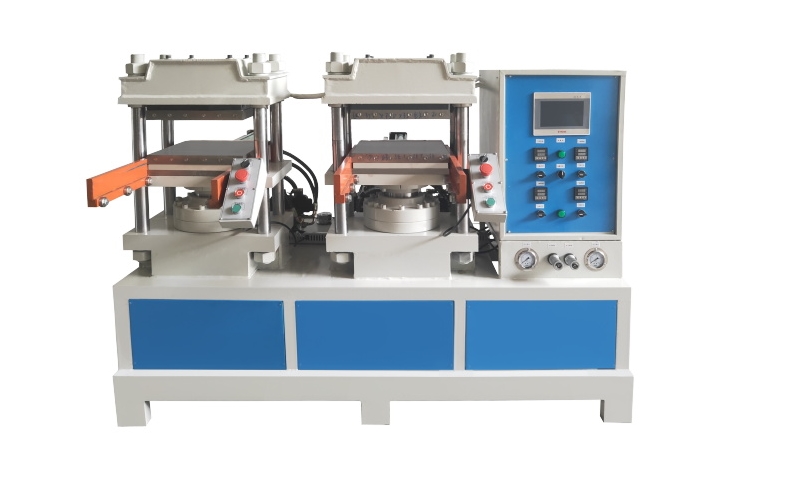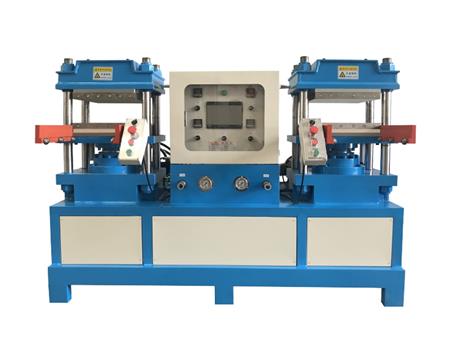
A hot Vulcanizing Machine is a device that uses high temperature and pressure to induce a chemical reaction in the vulcanizer in the rubber material. This process can improve the mechanical properties of the rubber, such as wear resistance, elasticity and anti-aging. Vulcanized rubber products are usually more durable and stable, and are suitable for a variety of industrial scenarios.

Model | YX-DJ50T |
Hot plate specification | 350*350mm |
Hot plate spacing | 150mm |
Cylinder diameter | 150mm |
Machine structure | Four column/single head/double head model |
System pressure | 18MPa |
Heating system | Imported electric heating tube |
Power supply specification | 380V/50HZ |
Essential details | |||
Place of Origin | China | Applicable Industries | Hotels, Machinery Repair Shops, Home Use |
Type | Showroom Location | None | |
Condition | New | Model | YX-DJ50T |
Video outgoing-inspection | Provided | Hot plate specification | 350*350mm |
Machinery Test Report | Provided | Hot plate spacing | 150mm |
Warranty of core components | 1 Year | Cylinder diameter | 150mm |
Core Components | PLC | Motor power | 3.75KW |
Voltage | 300V/50HZ | Temperature range | Normal temperature -350°C |
Dimension(L*W*H) | 1.4*2.2*1.5(m) | Working level | Upper and lower layer |
Warranty | 1 Year | Machine structure | Four column/single head/double head model |
Key Selling Points | Automatic | System pressure | 18MPa |
Power (kW) | 3.75 kW | Reducer casing | Power supply specification |
Weight (KG) | 2000 KG | ||
Hot vulcanizers are mainly used for the following purposes:
Manufacturing and repairing conveyor belts: For conveyor belts in mining, ports, construction and other fields, hot vulcanizers can effectively repair cracks and worn parts and increase the service life of conveyor belts.
Production of rubber products: For rubber products such as seals, hoses, tires, etc., which require precise control of hardness and elasticity, hot vulcanizers can achieve efficient and uniform vulcanization.
Combination of rubber and metal: Hot vulcanizers can combine rubber materials with metal skeletons and are often used to manufacture composite parts with high strength and wear resistance.
The main features of hot vulcanizers include the following aspects:
Precise temperature control: The equipment is equipped with a precise temperature control system to ensure constant temperature during the vulcanization process and avoid unstable product quality caused by temperature fluctuations.
Uniform pressure distribution: The advanced hydraulic system can provide uniform and continuous pressure to ensure that the rubber material is evenly stressed during the vulcanization process, thereby ensuring the quality of the finished product.
High vulcanization efficiency: Compared with traditional vulcanization methods, hot vulcanizers have faster vulcanization speeds, which can significantly improve production efficiency and reduce production costs.
Easy to operate, safe and reliable: Modern hot vulcanizers are usually equipped with automated operating interfaces and safety protection devices, which are convenient for operators to use and reduce the risk of accidents.
Adapt to a variety of materials: The equipment is suitable for a variety of rubber materials, including natural rubber, synthetic rubber, etc., to meet the needs of different industries.
In order to improve the performance and production efficiency of the hot vulcanizer, optimization can be carried out in the following aspects:
Upgrade the heating system: Introduce more efficient heating systems, such as infrared heating or electromagnetic heating, to reduce preheating time and energy consumption while ensuring temperature uniformity.
Intelligent control: By adding intelligent control modules, precise control of temperature, pressure and time can be achieved. Advanced control devices such as PLC (programmable logic controller) and touch screen can be used to improve the level of automation.
Optimize mold design: Improve the structure and material of the mold, reduce mold replacement time, and improve vulcanization efficiency. The precision and durability of the mold directly affect the quality of the finished product, so high-quality molds are the key to improving equipment performance.
Strengthen the cooling system: Optimize the cooling system to shorten the cooling time after vulcanization and further improve production efficiency. A circulating water cooling or air cooling system can be used to ensure that the rubber products after vulcanization are quickly cooled down.
Data monitoring and analysis: Introducing a data monitoring system to record various parameters in the production process in real time, facilitates analysis and optimization of the production process, reduces the defect rate, and improves the consistency of product quality.
Hot vulcanizers are widely used in multiple industries, including the following areas:
Mining and heavy industry:
Hot vulcanizers are mainly used in the mining industry to repair and maintain conveyor belts. Conveyor belts play an important role in transportation in mines and heavy industry production lines. As the use time increases, conveyor belts are prone to wear or breakage. Using hot vulcanizers can quickly repair damaged parts, increase the service life of conveyor belts, and reduce downtime.
Automotive industry:
In the automotive industry, hot vulcanizers are mainly used to manufacture and repair rubber parts such as tires, seals, and hoses. Through the vulcanization process, the durability and stability of these parts can be improved, ensuring the reliable performance of automobiles in various environments.
Petroleum and chemical industry:
In the petroleum and chemical industry, rubber seals and hoses need to withstand high pressure and corrosive environments. Hot Vulcanizing Machines can produce rubber products with good chemical resistance and mechanical properties to meet the special needs of this field.
Construction and Engineering:
Hot Vulcanizing Machines are often used in the construction industry to produce waterproof materials and shock-absorbing gaskets. These rubber products need to maintain long-term stability and reliability in harsh outdoor environments, and the hot vulcanization process can meet these requirements.
Consumer Goods Manufacturing:
Hot Vulcanizing Machines are also used to produce consumer products such as rubber soles and rubber parts in sports equipment. These products have high requirements for elasticity, wear resistance and appearance, and the hot vulcanization process can achieve fine quality control.
Hot Vulcanizing Machine plays a key role in modern industry. Its unique heating and pressurizing vulcanization technology can significantly improve the physical properties and service life of rubber products. Through continuous optimization and technological upgrading, hot vulcanizing machines have shown a wide range of application prospects in many fields. Especially in industries with high performance requirements for rubber products, the use of hot vulcanizing machines can ensure product quality while improving production efficiency and reducing maintenance costs.